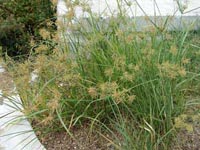Resource Library
Plant of the Week: Yellow Nutsedge
The University of Arkansas System Division of Agriculture does not promote, support or recommend plants featured in "Plant of the Week." Please consult your local Extension office for plants suitable for your region.
Plant of the Week
Yellow Nutsedge
Latin: Cyperus esculentus

I find my tolerance for weeds to be inversely correlated with the appearance of my lawn. The better the lawn, the more I notice weeds. This year it looks pretty good, thanks to a well timed herbicide application by one of our former students, so I’m noticing a new problem - yellow nutsedge. This pernicious weed has been there for years, but in a weedy lawn, what is another weed?
Yellow Nutsedge (Cyperus esculentus) is a perennial, grass-like weed found worldwide with a real fondness for moist ground. The Internet tells me that this is the world’s fifth most dangerous weed. Picture if you will, government agents of the FBW (Federal Bureau of Weeds) setting around a gray metal table working up a list of the ten most wanted weeds. Yeah, I have it, but so do you. It’s everywhere.
The nutsedges look a lot like grasses but belong to a completely different family, the sedge family. The 4,000 species of sedges are mostly denizens of low, wet ground while the 10,000 species of grass mostly prefer drier sites. Sedges have non-jointed, triangular stems with leaves borne in whorls of three; grasses have round, jointed stems with leaves borne in pairs.
Yellow nutsedge has shiny, yellow-green, v-shaped leaves that arise from the ground in groups of three. In the lawn it grows twice as fast as the fastest growing lawn grass, always sticking above the rest of the turf. If allowed to reach maturity it is about 18 inches tall when it produces a topknot of yellowish, apetalous flowers arranged in an umbrella like inflorescence. Two weeks after flowering, viable seeds are produced. In one study, about 1 percent of the seeds produced resulted in established plants, which doesn’t sound too bad until you realize thousands of seeds are produced.
But it is below ground where the real mischief occurs. Plants spread by a slender rhizome that travels in every direction from the original location. At the end of each rhizome a nutlet forms that will start new plants next season. A Georgia study found that a single nutlet produced 177 new plants occupying 2 square feet in a 6-month period. While this is just a pittance compared to its cousin the purple nutsedge that leads the FBW’s most wanted list, it is still quite impressive.
These nutlets - actually small tubers about one half inch long - persist in the soil for a year or more and can emerge from depths of at least three feet, should they find themselves buried that deep. The species epitaph for both tomato and yellow nutsedge is "esculentus" and was assigned by Linnaeus in the middle of the 18th century, telling us that both plants are edible. The tubers of one form of yellow nutsedge are grown as a food in parts of Africa and Asia where it is known as chufa. The Spanish prepare a drink called "horchata" from the nutlets that are said to taste like roasted almonds.
Controlling nutsedge in the lawn requires a bit of patience. Because it is a warm weather weed, most of the dormant nutlets will have emerged by early June, the ideal time to spray for this weed. Manage and Image are two new selective herbicides that give good control, but don’t expect a single application to completely remove it from the turf. Complete control will require treating during two seasons to assure all of the dormant nutlets are killed.
By: Gerald Klingaman, retired
Extension Horticulturist - Ornamentals
Extension News - September 5, 2003
The University of Arkansas System Division of Agriculture does not maintain lists of retail outlets where these plants can be purchased. Please check your local nursery or other retail outlets to ask about the availability of these plants for your growing area.